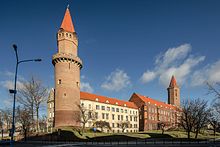Liegnitz Castle
Liegnitz Castle ( Polish: Zamek Piastowski w Legnicy - Piastenschloss Liegnitz) is located on the northern edge of the old town of Legnica (Liegnitz).
history
The castle goes back to a castle complex at the river crossing over the Katzbach (Kaczawa), which secured the High Road from Wielkopolska via Glogau to Bohemia. Around the 11th century the Trebowans built a wood-earth fortification on an artificial hill. To the east, another rampart was added later, and the castle became the seat of an early piastic castellany, which is documented in 1175.
Under Boleslaus I, the seat of government of the Duchy of Silesia, the wooden fortifications were replaced by the first brick castle complex in Poland, possibly with the support of the Cistercians from Altzella Monastery . The Lüben Gate Tower was built in the north and was connected to the octagonal Petersturm via a defensive wall. A three-storey hall and the twelve-sided Laurentius Chapel were built next door. In the entrance area to the west, secured by the Hedwigsturm, there were commercial buildings.
Under Boleslaus II , the city was re-established under German law after the Mongol storms. With the partition of Silesia, Liegnitz was expanded in 1248 and the seat of government and the castle. In 1416 the two main towers were raised with octagonal essays and cantilevered walkways. This work was carried out by the builders' workshop of the Saint Denis basilica in Paris.
With the extinction of the Liegnitz line of the Piasts, Ludwig II became heir to the duchy. From 1453 to 1488, under Frederick I, the hall was expanded to the east. His son Friedrich II had a two-aisled ballroom set up on the middle floor of the palace, with portraits of emperors and dukes of Liegnitz on the wall. An arcade gallery was created on the courtyard side, which was later removed. The fortification was also reinforced with earth walls, in the eastern flank of which Georg von Amberg and possibly also Wendel Roskopf created a magnificent portal. In the frieze of the portal there were portrait medallions of Friedrich and his wife Sophie von Brandenburg-Ansbach , which were removed in 1945 when they were too little Polish.
Duke Georg Rudolf had two wings built in the northeast corner around 1620. In addition, the castle chapel was demolished and a clock tower was built instead.
From 1675 the castle was the seat of the Austrian governor . After 1741 the complex lost its defensive character when the ramparts and fortress walls were removed. From 1809 the castle was the seat of the Prussian Oberamt. After a fire in 1835, the palace was rebuilt in neo-gothic forms according to plans by Karl Friedrich Schinkel . a. a crenellated wreath and a crowd watch tower, rebuilt. The interiors were redesigned in 1845 by Friedrich August Stüler and had a transit area for the king and exhibition areas for the arts and crafts collections of Friedersdorf Castle . In 1867 the closing wall to the farm yard was replaced by a connecting wing and a clock tower in the arched style .
During the Second World War , the castle was destroyed except for the outer walls. After the administration was taken over by the People's Republic of Poland , the ruins were secured and rebuilt from 1958 to 1964, removing the neo-Gothic character, and exposing the original Piastic fortifications to underpin the town's original Polish character.
Today the educational institutions are housed in the castle. The excavations of the Laurentius Chapel are made accessible in a museum pavilion.
literature
- Arne Franke (Hrsg.): Small cultural history of the Silesian castles . tape 1 . Bergstadtverlag Wilhelm Gottlieb Korn, 2015, p. 63-65 .
Web links
Coordinates: 51 ° 12 ′ 40.9 ″ N , 16 ° 9 ′ 46.1 ″ E








